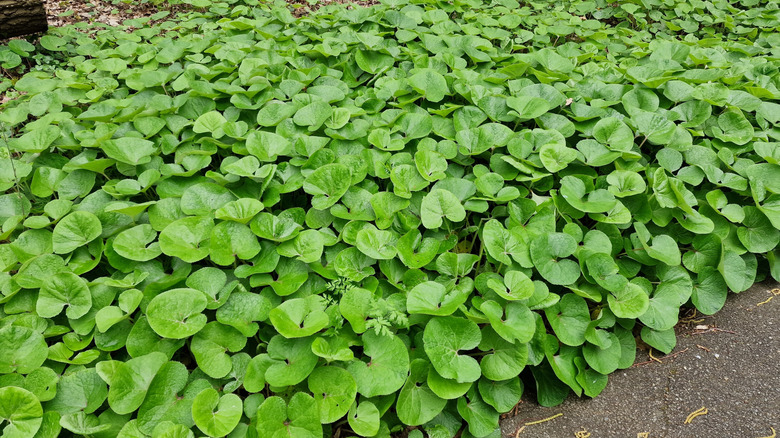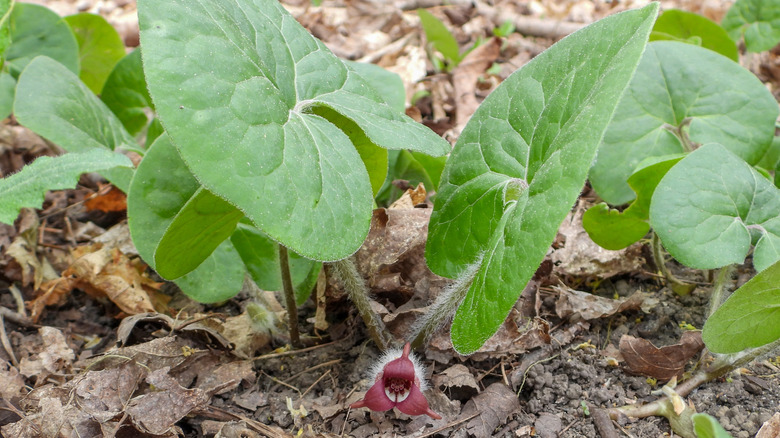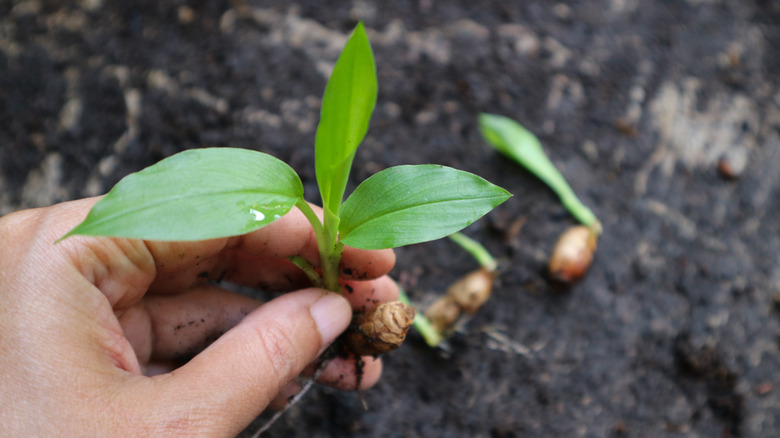The Toxic Downside You Should Know Before Growing Wild Ginger
Wild ginger (Asarum canadense) is an increasingly popular choice for gardens thanks to its attractive heart-shaped foliage, shade tolerance, and mild ginger fragrance. The North American native spreads steadily via rhizomes to create a lush ground cover that looks great on its own or in a mixed bed with other ground cover plants that love shade. However, don't let the similar name and fragrance fool you. Wild ginger is not even in the same family as the ginger root (Zingiber officinale). More importantly, it's not recommended as a culinary substitute for ginger because it contains potentially harmful compounds.
Specifically, wild ginger contains aristolochic acids, a set of toxins that the Food and Drug Administration (FDA) has issued a warning about, citing a possible link to kidney disease and cancer. So, if you were hoping to use fresh-picked wild ginger in your cooking to add a flavorful kick, there are less harmful plants to add to your culinary garden. Even if you weren't planning to use it in the kitchen, you may want to choose a safer alternative if you have pets that roam outside, and you're worried about them potentially munching on the toxic leaves. But even though it's not a plant you should add to your ingredient list, wild ginger is still a great ornamental ground cover to use in your landscape for all the qualities mentioned above. The low-growing, colony-forming native is a great ground cover alternative for vinca minor and other invasive species in your garden.
Why you shouldn't eat wild ginger
As mentioned above, wild ginger contains aristolochic acid. This is a toxin that research has shown to be potentially carcinogenic and nephrotoxic. Specifically, consuming this compound has been associated with urinary tract cancers and kidney disease. The exact concentration of aristolochic acid in wild ginger varies but can reach 2.6 milligrams per gram. According to a study published by Kidney Research and Clinical Practice (via the National Library of Medicine), it takes a cumulative dose of just half a gram of the toxin to cause chronic kidney disease.
Because conditions like cancer and kidney disease take time to develop, the toxicity of aristolochic acid-containing plants like wild ginger isn't something you immediately notice like, say, poison ivy and its rash-inducing urushiol oils. So, you might be able to consume wild ginger for some time without noticing a problem. This is part of the reason you may have heard of wild ginger being used as a medicinal plant or at least enjoyed as a flavorful tea.
If you're surprised to find out it's toxic or you've consumed wild ginger in the past, you're not alone and you're not necessarily doomed. However, it is a good idea to stop consuming wild ginger now to be safe; instead, simply appreciate the plant as the perfect ground cover for shady areas of your yard. However, if you're concerned about the toxicity, there are several alternatives you can plant instead.
Wild ginger alternatives to plant if you're worried about toxicity
If you're hoping for home-grown ginger flavor, consider planting culinary ginger. The aromatic root is fairly easy to grow in containers indoors or on your deck, as it prefers warmth and shade. That said, it can take up to 10 months for your first harvest. Galangal (Alpinia galanga), sometimes called Thai ginger, looks similar to ginger and can be grown in much the same way. However, it has more of a citrusy, pine-like aroma that some say tastes similar to ginger, but isn't a perfect substitute.
If you don't plan to eat it, and just need a pet-friendly ground cover to fill in a shady spot, you have a lot more options. For similar-looking foliage, try common blue violet (Viola sororia), which is a great low-maintenance native ground cover that tolerates just about any light conditions in zones 3 through 9. Other shade-tolerant native ground covers to consider include alumroot (Heuchera americana), prairie sage (Artemisia ludoviciana), and sedges like Pennsylvania sedge (Carex pensylvanica) or low woodland sedge (Carex socialis). There are also many native ferns that thrive in shade and add great texture to a mixed garden bed.


